| < Prev | Next > |
|---|
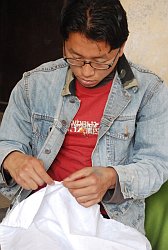 Thangkas are Buddhist paintings of religious origin and background. Today they are still made, mainly in Nepal, Bhutan, Tibet and in India. Over the last decades the thangka changed from an object of religious veneration to an art object that is appreciated by collectors and art friends worldwide.
Thangkas are Buddhist paintings of religious origin and background. Today they are still made, mainly in Nepal, Bhutan, Tibet and in India. Over the last decades the thangka changed from an object of religious veneration to an art object that is appreciated by collectors and art friends worldwide.
In spite of the influence of western culture and tourism in Nepal during the 1960s until the 1990s, the high quality level in artisanship and the use of old tools and materials has not been changed. Thangkas are available in different qualities and for prices that are very low compared to the required effort in time and skill.
The Workshops
Thangkas are still made to hundred percent by hand. They are created either in small workshops, operated by an owner and typically by up to 20 painters and apprentices. Or they are created by freelance painters who work at home. Important for thangka painters is that they have one or more dealers who buy the finished thangkas from them. Larger dealers often have workshops of their own and thus bear the full commercial risk.
Thangka painting shops are usually bare rooms with sufficient light. The painters are sitting cross-legged in front of a large wooden frame to which the canvas is fixed.
Materials and Tools
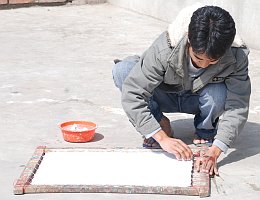 Thangkas are painted on cotton tissues with colors similar to tempera. Old writings like the "Manjushrimaulakalpa" from around 300 AC require that the cotton must be woven by a virgin. But such strict regimentations have very little meaning today. Most thangka painters see their craft as a means to earn a livelihood.
Thangkas are painted on cotton tissues with colors similar to tempera. Old writings like the "Manjushrimaulakalpa" from around 300 AC require that the cotton must be woven by a virgin. But such strict regimentations have very little meaning today. Most thangka painters see their craft as a means to earn a livelihood.
The colors used are from minerals or vegetables which are mixed with glue and water.
Preparing the Canvas
Now the cotton is coated on both sides with a kind of glue that is applied in several layers. The coating prevents the color from being soaked up and from later damages like fading or chipping off pigments. Finally the surface is polished.
The Iconography
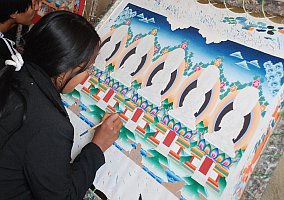 The design follows old iconographic templates. These templates allow only small variations. The creation of a new design is restricted to masters. When you look at the thangkas made during the last decades, you will recognize a certain change in style and preferred designs. Although the drawings are kind of fixed by traditional regimentations, one can see a development of artisanship over a longer period.
The design follows old iconographic templates. These templates allow only small variations. The creation of a new design is restricted to masters. When you look at the thangkas made during the last decades, you will recognize a certain change in style and preferred designs. Although the drawings are kind of fixed by traditional regimentations, one can see a development of artisanship over a longer period.
The iconography of thangkas used to be documented in writings that were often kept in family property. The old regimentations allowed the painter hardly any personal style.
Getting the Template on the Canvas
First the iconographic design is drawn on a piece of sketching paper. Along the outlines of the drawing thin holes are applied. This makes a grid-like pattern on the paper surface.
The sketching paper is fixed on the thangka canvas und coated with char coal or powder. Thus the outlines of the drawing are visible on the canvas.
Starting to Paint
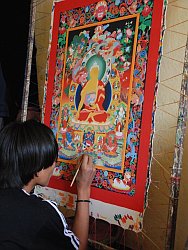 The artist begins by painting the larger, flat areas. Usually he will start with the light colors first and then move over to the darker tones.
The artist begins by painting the larger, flat areas. Usually he will start with the light colors first and then move over to the darker tones.
Originally the colors had a religious meaning. Today the harmony of the color selection is regarded as paramount. This allows the painter more individual freedom. Collectors and art friends familiar with thangka painting put much importance on the final harmony of color combinations.
The paints used are of of mineral or vegetable origin. The young apprentices are usually responsible for the preparation of the paint. They use small bowls to pulverize the original ingredients and mix them with water and glue.
As in many Asian cultures, the individual colors have certain meanings like calm, pride or passion.
Gold has a very special meaning. Real gold is used for the best and most expensive thangkas. The methods how the original material - gold plates or gold dust - are pulverized and mixed so that they are usable for painting, is kept as a secret by the workshops. There is a difference between real gold and golden colors. With some experience you can see the difference clearly. Only thangkas painted with real gold have this fascinating shining.
Painting of Details and Gradations
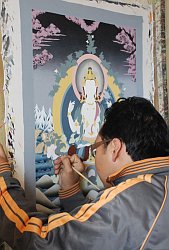 After the painting of the larger, flat areas, the paint first has to dry thoroughly. All subsequent steps can only be performed by trained, experienced thangka painters.
After the painting of the larger, flat areas, the paint first has to dry thoroughly. All subsequent steps can only be performed by trained, experienced thangka painters.
Next gradations are applied. These give the thangka image a more three-dimensional look.
As in quite a few Asian art forms, the drawing is reinforced by applying outlines. These are drawn with a very thin pencil - often in black or in dark ocker colors.
At the end the faces and the eyes of the gods and goddesses are painted. Being paramount for the quality of a thangka, this last step is performed by the master himself. In earlier times this step was accompanied by religious rituals and was called "eye opening". This last step was seen as bringing the thangka to life.
The very last step is the polishing of the finished thangka. Thus the gold colors get that brilliant luminosity.
The Cloth
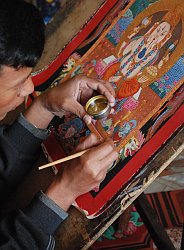 Once the painting was done, the thangka is taken out of the wooden frame. Now the cloth is applied. The cloth is held stable on top and on bottom with a wooden rod. Metal cabs may be attached to the bottom rod on each side. The cloth is made out of brocade or silk.
Once the painting was done, the thangka is taken out of the wooden frame. Now the cloth is applied. The cloth is held stable on top and on bottom with a wooden rod. Metal cabs may be attached to the bottom rod on each side. The cloth is made out of brocade or silk.
The cloth is often nicely decorated - with lotus flowers, Buddhist symbols and ornaments. The quality of the cloth is usually chosen according to the quality of the thangka.
On the upper end of the cloth is a thin silk cloth attached. It serves to cover and protect the thangka image when it is not used for prayer or meditation.
The Price of a Thangka
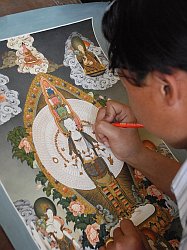 Small thangkas of an acceptable quality are available starting at $ 100. For good medium and large-sized qualities you should be willing to spend ca. $ 500 and more. The best top qualities start at $ 1,000. Such pieces are still created but they are rare. The market for such pieces is rather small.
Small thangkas of an acceptable quality are available starting at $ 100. For good medium and large-sized qualities you should be willing to spend ca. $ 500 and more. The best top qualities start at $ 1,000. Such pieces are still created but they are rare. The market for such pieces is rather small.
From the point of view of an art friend for instance in the USA, the European Union or in Japan such prices are ridiculous in relation to the amount of work that the creation of a thangka requires. This is only possible due to the huge difference in wealth between highly developed nations and countries like Nepal which is among the poorest nations on this earth.
If you are from the generation of adventurers who traveled in Asia with a backpack in the 1960s and 1970s on a 5 dollar per day budget, you will find out today that many of these countries like for instance Malaysia or Thailand have kept up tremendously and are today on a price level comparable to Western nations. Other countries like India or China are now keeping up with huge leaps forward. In my view international globalization will lead on long term to a leveling off of the large differences in the wealth of nations.
Nepal could preserve its high level of great artisanship. It is one of the few regions in this world where you can still buy unique and incredible works of art and artisanship for an "apple and an egg". But for how long? Quite frankly, I wish for the people of Nepal and Tibet that this may change soon.
Dieter Wanczura
Literature source for this article
- Thangkas, Rollbilder aus dem Himalaya, Kunst und mytische Bedeutung, Dumont Buchverlag, Köln, Alexandra Lavizzari_Raeuber, 1984, ISBN 3-7701-1408-6







